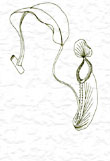

 |
 |
Invertebrates
Additional Noctuidae (Lepidoptera) to the Hong Kong List
by Roger Kendrick
Acidon paradoxa Hampson, 1896 [Lepidoptera: Noctuidae, Hypeninae] was recorded from KARC in October 2000 and in each month subsequently (to late April), including records from the butterfly garden at KFBG in 2001. Prior to these records, the species was only known from the holotype specimen, found in Bhutan and described by G.F.Hampson in 1896. My thanks to Dr. Martin Lödl, Vienna, Austria, for identifying the species from the photo and for providing the background information of the species' past history.
Nothing is known about the early stages of this species' life history. That this species was not recorded during three years of intensive work at KARC from 1997-1999, yet appeared regularly over seven months in 2000 / 2001, illustrates just how variable population levels of insect species can be and how little is known about the factors regulating many insect species abundance in the tropics. Geographical Range: China (Hong Kong NEW RECORD), Bhutan (Lödl, 1998)
Two individuals of Athetis delecta (Moore, 1881) (Caradrina) [Lep.: Noctuidae, Amphipyrinae] were recorded at a light trap in Lam Tsuen Valley, 24 February 2001. Geographical Range: India (Darjelling), Nepal, China (Jiangsu, Xiziang, Hong Kong NEW RECORD) (Poole, 1989; Yoshimoto, 1992, Chen, 1999). This represents a considerable range extension for this species.
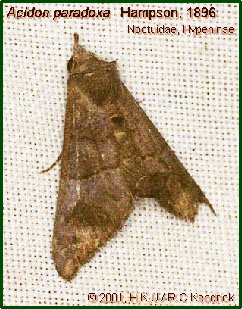 |
Bibliography
Chen, Y.X. (1999). Fauna Sinica Insecta Vol. 16: Lepidoptera; Noctuidae. Science Press, Beijing. lxxiii + 1596 pp., 701 figs., 67 plates (b/w).
Lödl, M. (1998). Revision der Gattung Acidon Hampson, 1896 (Lepidoptera: Noctuidae: Hypeninae), Quadrifina 1: 25-62.
Poole, R.W. (1989). Lepidoptorum Catalogus (New Series). Fascicle 118: Noctuidae. E.J.Brill, Leiden.
Yoshimoto, H. (1992). Noctuidae. In Haruta, T. (ed.) Moths of Nepal, part 1. Tinea 13 (Suppl. 2): 50-69.
P.4
![]()
Interesting Odonates from Hong Kong Island
by Michael Lau
On 11 May 2001, one Calicnemia sinensis was found near a forest stream along Mount Parker Road at about 140 m. Two Drepanosticta hongkongensis were found near a small stream at about 210 m. Several Drepanosticta hongkongensis and two Sinosticta ogatai were found along a forest stream south of Quarry Gap from 180 – 260 m. According to Wilson (1997b) C. sinensis is a regionally rare species with restricted local distribution. It has been recorded from five sites in Hong Kong (Wilson, 1997) and this Mt. Parker record represents the sixth site. Both D. hongkongensis and S. ogatai are believed to be endemic (but see Reels’ article in this issue of Porcupine!) and have never been recorded on Hong Kong Island (Wilson, 1997b). Their presence in the Mount Butler area is hence of conservation interest.
P.4
![]()
Two Hong Kong ‘endemics’ sunk at Wutongshan
by G.T. Reels
Two species of damselflies previously only known from Hong Kong have been discovered on the slopes of Wutongshan in Shenzhen. Sinosticta ogatai and Drepanosticta hongkongensis (Platystictidae) were both found in good numbers in wooded ravines on the north-facing slopes of the 944 m mountain, just over the border from Sha Tau Kok, during a field visit organized by Kadoorie Farm & Botanic Garden on 16-17 May 2001.
Sinosticta ogatai (Matsuki & Saito, 1996) was first discovered by KDP Wilson, who recognised it as a new genus of Platystictidae, in May 1994 at Tai Mo Shan and Keung Shan (Wilson, 1995). It was subsequently erroneously described as a new species of Drepanosticta by Matsuki & Saito (1996), and re-described by Wilson (1997a), who created the monotypic genus Sinosticta to receive it. The species has also been recorded at Ng Tung Chai and Sunset Peak (Wilson, 1997b), and recently at Tai Tam (M. Lau, pers. comm.).
Drepanosticta hongkongensis Wilson, 1997 was first recorded in Tai Po Kau by Asahina (1987), who mis-identified it as D. brownelli. It was described as a new species by Wilson (1997a) on the basis of colour differences from the latter on segments 8-10 of the male abdomen. It is known from several sites across the SAR (e.g. Wilson, 1997b).
The north-facing slopes of Wutongshan are steep and relatively well-wooded. The mountain represents a continuation of the SW-NE trending uplands which comprise much of Hong Kong’s landscape, and it is quite possible that another endemic damselfly, Rhipidolestes janetae (Megapodagrionidae), could turn up on the mountain’s upper slopes. The species is currently known only from Sunset Peak on Lantau Island.
Bibliography
Asahina, S. (1987). A revised list of the Odonata of Hong Kong. Part 1: Zygoptera. Tombo 30: 7-24.
Matsuki, K. & Saito, Y. (1996). A new species of Drepanosticta from Hong Kong (Odonata: Platystictidae). Nature and Insects 31: 39-43.
Wilson, K.D.P. (1995). Hong Kong Dragonflies. Urban Council, Hong Kong, 211pp.
Wilson, K.D.P. (1997a). The Platystictidae of Hong Kong and Guangdong with descriptions of a new genus and two new species (Zygoptera). Odonatologica 26: 53-63.
Wilson, K.D.P. (1997b). An annotated checklist of the Hong Kong dragonflies with recommendations for their conservation. Memoirs of the Hong Kong Natural History Society 21: 1-68.
P.5
![]()
Barnacle species new to science recorded in Hong Kong!
by Yan Yan and Benny K. K. Chan
A tiny barnacle with mature egg masses (basal diameter ~ 5 mm) has been discovered in the exposed intertidal region (1.5 – 2 m above Chart Datum) at Cape d’Aguilar, Hong Kong (Fig. 1). The barnacle is clearly of the genus Chthamalus and can also be found on the shell surface of the bivalve Septifer virgatus, the gastropod Nerita albicilla, and also other barnacles such as Capitulum mitella and Tetraclita squamosa. In Hong Kong, only two species (Chthamalus malayensis and Euraphia withersi) belonging to the family Chthamalidae have been recorded. Chthamalus species are variable in adult morphology and thus often difficult to distinguish. By detailed investigation of the adult and larval morphology of this species, however, certain diagnostic features have been discovered in the scutum, tergum (plates at the barnacle's opercular opening) and also the cyprid larvae (settling stage) which distinguished this species from previous descriptions of all Chthamalus species in the world. This species, therefore, is proposed to be a new species which has been neglected by people - even by barnacle lovers! Currently, we are preparing a manuscript to describe this new species.
Fig.1 Adults of the new Chthamalus species discovered in the mid-high shore region at Cape d’Aguilar.
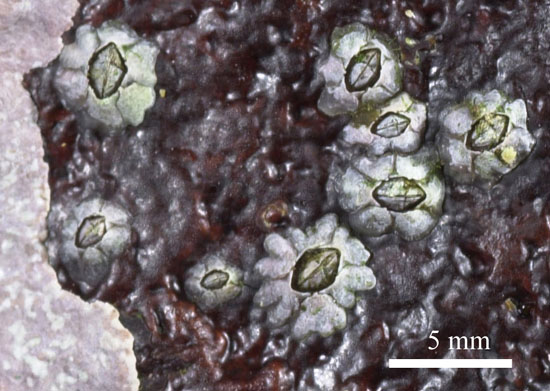 |
P.5
![]()
Sacculina in Hong Kong: A special form of barnacle you may never have noticed!
by Benny K. K. Chan and David Y. N. Poon
What are barnacles? If you say that they are sessile feeders having conical shells and bearing six pairs of appendages on their bodies, then you just got it half right! In fact, not all barnacles have conical shells or even a definite body form. Rhizocephalan barnacles (Cirripedia: Rhizocephala), which parasitize marine and freshwater crustaceans (in particular the crabs and shrimps), are one of the exceptions.
The genus Sacculina is one of the Rhizocephalan barnacles that parasitizes crabs. Similar to other barnacles, Sacculina have a planktonic larval stage, the nauplius, and a settling stage, the cyprids. The adults, however, unlike other typical barnacles, are internal parasites (called the "interna"), cuticular tumors which grow inside their crustacean hosts. These tumors can develop a system of branching roots that ramify throughout their hosts’ bodies and absorb their nutrients. The life cycle of Sacculina, therefore, comprises two stages: the endo- and ecto-parasitic stage.
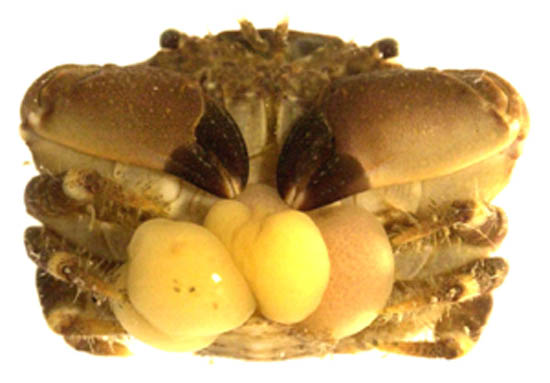 |
Sacculina larvae are dioecious. The male larvae are often smaller than those of the females. The life cycle begins with the female cyprid invading the crabs and then developing into a parasite with an internal root system (interna). Once the interna matures, it will develop a reproductive body outside the crabs through the abdominal part called the virgin externa. Male cyprids will then enter the virgin externa, which give rise to a fertilized externa with the eggs brooding inside it. Larvae will then be released via the externa once the eggs became mature.
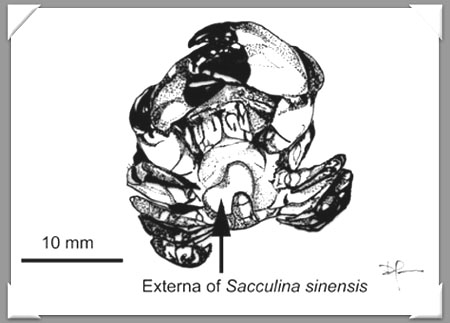 |
The life cycle of Sacculina is complex and specialized, their distribution is, therefore, often localized and confined to very sheltered areas. For details about the life cycle and ecology of Sacculina, interested readers should see the review written by Hoeg and Lutzen (1995).
Identification of Sacculina is very difficult and often relies upon identification of their hosts (they are usually host-specific) as well as microscopic investigation of the transverse sections of the reproductive structure i.e. the externa (Hoeg et al., 1990).
Investigations of Sacculina infestations are often restricted to temperate species and little is reported from tropical intertidal regions. In Hong Kong, so far there are no detailed investigations of Sacculina infestations, the only records of Sacculina (parasitizing crabs) being those of Morton and Morton (1983) and Morton (1994). In January 2001 we discovered that the intertidal crab Leptodius exaratus was occasionally found bearing externae of Sacculina at Lobster Bay (a sheltered boulder shore) in Cape d’Aguilar. Investigation of the externa transverse sections revealed that this Sacculina species is Sacculina sinensis, which was once found by Baushma in Hong Kong in 1933. The size of the externa of S. sinensis is small with a mean width of 5 mm. By culturing the larvae of S. sinensis, we found that there are 4 naupliar stages and 1 cyprid stage. All the larvae are non-feeding and the limbs (antennules, mandibles and antenna) are structurally simple. Through extensive searches of crabs in a variety of intertidal shores around Hong Kong, only L. exaratus on boulder shores in Cape d’Aguilar and Lan Lai Wan in Tai Tam (Hong Kong Island) were found to have Sacculina infestation.
The infection rate and occurrence of Sacculina spp. are lower in Hong Kong compared to other South-Asian regions. In Taiwan, the infection rate of Sacculina spp. on crabs often reached 30 – 40 % and hosts included the rocky shore crabs Grapsus albolineatus, G. intermedius and G. longitarsis (Liu and Lutzen, 2000). In Japan, the crab Gaetice spp. is also found to be infected by Sacculina. In Hong Kong, Sacculina infestation has only been recorded for the crab Leptodius exaratus (the record of Sacculina confragosa parasitizing the crab Epixanthus frontalis in Morton 1988 is suspected to be a misidentification) and the infection rate is only around 10 % at Lobster Bay and in another boulder shore near Lap Sap Wan. In addition, so far neither Grapsus spp. nor Gaetice depressus in Hong Kong has been observed to have signs of Sacculina infestations. We are now preparing a manuscript describing the adult and larval morphology of S. sinensis and comparing its occurrence with other Asian regions. The differences of infection rate and also the crab species infected between Hong Kong and other Asian region is a potential area for further research.
Bibliography
Dai, A.Y. and Yang, S.L. (1991). Crabs of the China Seas. China Ocean Press, Beijing.
Hoeg J. T. and Lutzen, J. (1995). Life cycle and reproduction in the Cirripedia Rhizocephala. Oceanography and Marine Biology: An Annual Review 33: 427-485.
Hoeg, J. T., Kapel, C. M., Thor, P. and Webster, P. (1990). The anatomy and sexual biology of Boschmaella japonica, an Akentrogonid Rhizocephalan parasite on barnacles from Japan (Crustacea: Cirripedia: Rhizocephala). Acta Zoologica (Stockholm) 71: 177- 188.
Liu, H-C and Lutzen, J. (2000). Asexual reproduction in Sacculina plana (Cirripedia: Rhizocephala), a parasite of six species of Grapsid crabs from Taiwan. Zool. Anz. 239: 277-287.
Miyake, S. (1983). Japanese Crustacean Decapods and Stromatopods in Color Vol. II: Brachyura (Crabs). Hoikusha Publishing, Osaka (Japanese text).
Morton, B. (1988). Partnerships in the Sea. Hong Kong University Press, Hong Kong. 124 pp.
Morton B. and Morton J. (1983). The Seashore Ecology of Hong Kong. Hong Kong University Press, Hong Kong. 350 pp.
P.6-7
|
Porcupine! |
 Copyright © 2000 |